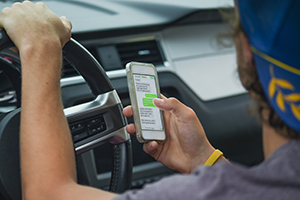Distracted driving — take part in the solution
Community Health and Wellness Specialist
CentraCare Health – Monticello
Recently, I was fortunate to attend “Disrupting Distraction”, a program held at the University of Minnesota. The program explored the latest data and research around distracted driving, why we do it and the promising approaches to tackling this important health problem.
The opening presentation featured a conversation by two families affected by distracted driving to honor lives lost and to inspire action. One of these families is well known to me, not only are they from my hometown, but I have had the honor to work alongside them to raise awareness of distracted driving and provide education in our local communities.
These families shared their children’s “unfinished stories,” the lives they may have had if distracted driving had not cut them short. The families’ amazing resilience and dedication to making distracted driving socially unacceptable encourages me to work harder in this area as well. Watch Phil's Unfinished Story below.
We all know that distracted driving is an epidemic. In fact, our most recent Community Health Assessment Survey in Wright County (home of CentraCare Health — Monticello) showed that distracted driving is viewed as one of the top health issues facing our county. However, those same survey respondents admitted to reading or sending texts (42%), making or answering a phone call (85%) or doing other activities such as eating, drinking, putting on makeup, etc. (44%).
We recognize the issue, yet we engage in the exact behavior that we report as a huge problem. This is a scary reality. Many people often feel that they themselves do these behaviors safely and that the problem lies in other drivers on the road.
So, what can we do?
1. Make your own commitment to driving safely at all times.
- Put your phone in the trunk or out of reach
- Pull over to answer or make calls and texts
- Install an app that automatically responds to your texts while driving to let others know that you are not currently available
- And eat your drive-thru meal in a parking spot before leaving the restaurant.
2. Second, model safe driving to others. Our children will follow our example so this is a big opportunity to do what’s right. Do not drive distracted and empower your children and others to speak up when they need to remind someone else to be safe on the road.
3. Lastly, educate others and encourage policy changes to reflect safe driving in your business or organization. Laws, technology and safer vehicles cannot be the only answers to solving this epidemic. We need to be involved. It will be up to all of us to tackle this issue.
